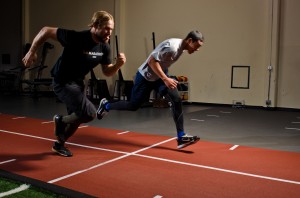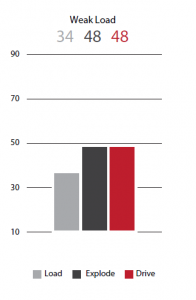
Being a coach sometimes feels like being a parent on a road trip with kids asking, “Are we there yet?” every 5 miles. Athletes want to know when they are going to improve, by how much, and when can we assess again. It is one of the most critical aspects of sports science; providing data that can validate an athletes’ efforts (or lack thereof), as well as redirect priorities to ensure optimal preparation.
With traditional testing (max sprint, 1 RM, conditioning tests), it often takes weeks or months to assess improvements, generally because the movement is a skill (just ask a power lifter, Olympic lifter, or sprinter) and the intensity cannot be replicated often. So at Sparta, we look at movement sequencing; how strong, fast, and smooth you can operate. This Sparta Signature can be assessed on a daily basis, but more importantly, real changes statistically occur in just five days.
An athlete’s standard training program, and many monitoring protocols, work off a weekly system of seven days, often called a microcycle in periodization nomenclature. The seven days is arbitrarily chosen because it fits into a calendar week; train hard on a Monday when you are fresh after a weekend or at least Sunday off, followed by a gradual decline in focus and intensity throughout the week before the process is repeated.
But what if you were wasting two days with every microcycle? Changes could be made sooner, and over the course of the year you could add 22 more weeks! Whether by chance or some secret, professional baseball has figured it out, having their pitchers throw every five days.

We had one of the top universities’ statistics advisors look at three years of our force plate data on Movement Signatures to find that the average time for real, not random, changes were made in five days. Our standardized data showed that values usually increased if the training prescriptions were followed. LOAD was the one variables that decreases, which we have indicated in the past to be a marker of fatigue, particularly the muscles of the ankle and knee.
We know some Sparta Signature changes are made immediately by improving awareness of the sequencing of joints and muscles in a more efficient manner. The other major adaptation made during this time period is structural. Muscles get damaged (sore), subsequently producing less force. A 2013 study out of Slovenia is one of the few projects that looked at the effects of intense exercise on the countermovement jump during this short five day period.
Specifically, the authors investigated damage from leg curls, an exercise aimed at the distal hamstrings closer to the knee joint rather than the hip. The majority of the deficits from muscle damage were found in the vertical jump test, as opposed to a squat jump test, balance test on one leg, and leg stamping (like a speed ladder drill). The rate of force production was the only value that remained low for the entire recovery period.
Vertical jump is the most sensitive athletic test for monitoring fatigue, due to lack of skill required/ease of use
Fatigue has greatest negative affect on LOAD, often signified by lower leg soreness (quads or distal hamstring)
Full recovery occurs at five days, so if schedule permits, save 21 weeks a year, by shortening the microcycle
Sarabon N, Panjan A, Rosker J, Fonda B. Functional and neuromuscular changes in the hamstrings after drop jumps and leg curls. Sports Sci Med. 2013 Sep 1;12(3):431-8.